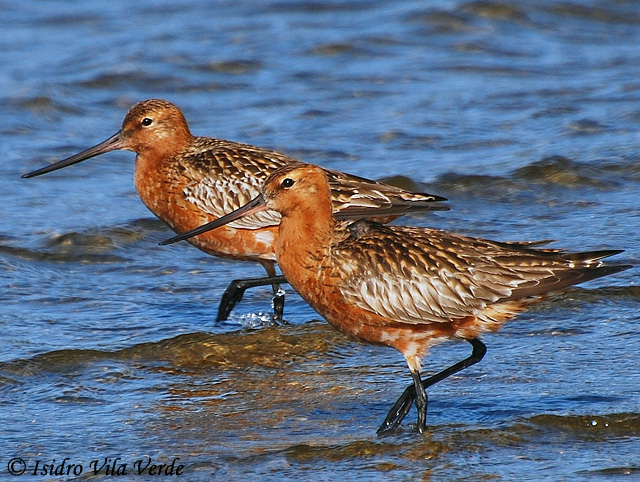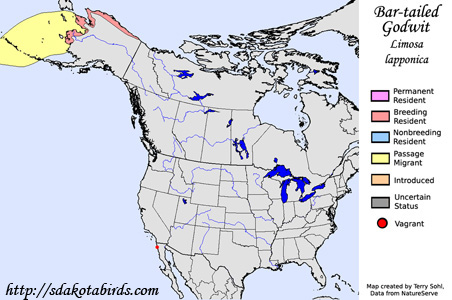Bar-tailed Godwit
Limosa lapponica
| Length: 16 inches | Wingspan: 30 inches | Seasonality: Non-resident in South Dakota |
| ID Keys: Long upcurved bill, grayish with streaks in non-breeding plumage, males in breeding plumage have bright rufous on head and underparts. | ||
 The
Bar-tailed Godwit is found widely across northern Europe and Asia during the
summer months, but in North America, their range is limited to western and
northern Alaska, where Bar-tailed Godwits congregate during the summer
breeding season on open, hilly tundra. They are long distance
migrants, with birds that breed in Alaska migrating to Australia or
southeast Asia for the winter. Note the photo to the right shows two
breeding plumaged males. Coloration of the species is much more muted
in non-breeding plumage, as both males and females take on a mostly grayish
tone.
The
Bar-tailed Godwit is found widely across northern Europe and Asia during the
summer months, but in North America, their range is limited to western and
northern Alaska, where Bar-tailed Godwits congregate during the summer
breeding season on open, hilly tundra. They are long distance
migrants, with birds that breed in Alaska migrating to Australia or
southeast Asia for the winter. Note the photo to the right shows two
breeding plumaged males. Coloration of the species is much more muted
in non-breeding plumage, as both males and females take on a mostly grayish
tone.
Habitat: Found on hilly open tundra on their summer breeding grounds, in areas with scattered short shrubs. In migration and in winter, they are mostly found on coastal mudflats.
Diet: Feeds mostly on insects during the summer breeding season, as well as some seeds and berries. In migration and in winter, they feed on marine creatures such as mollusks, crustaceans, and marine worms.
Behavior: Forages by walking along the ground in search of insects during the summer months. At other seasons, they walk along mudflats, probing in the mud for food items, or picking up food items directly from the ground.
Nesting: The nest of a Bar-tailed Godwit is a shallow depression on the ground, lined with small amounts of mosses, lichens, and grasses. The female lays 4 eggs, and both parents help to incubate them. When the eggs hatch, the young leave the nest and must find their own food, but both parents tend to them and protect them from predators.
Interactive eBird Map: Click to access an interactive eBird map of Bar-tailed Godwit sightings
Song: Flight call is a series of nasal notes, kee-kee-kee.
Migration: Strongly migratory, with birds that breed in Alaska wintering in Australia, New Zealand, or southeast Asia.
Similar Species: Black-tailed Godwit, Hudsonian Godwit
Conservation Status: Populations are in decline, but overall the species is not in immediate danger. They are found over a wide geographic area, breeding across large parts of northern Europe and Asia, and are common in some areas. The IUCN lists the Bar-tailed Godwit as a species of "Least Concern".
Further Information: 1) BirdWeb.org - Bar-tailed Godwit
2) PRBO Conservation Science - Bar-tailed Godwit
3) Bar-tailed Godwit - Audubon Guide
Photo Information: Photo taken by Isidro Vila Verde - May 4th, 2008 - Gaia, Portugal - Photo licensed under Creative Commons Attribution NonCommercial 2.0 Generic License.
| Click below for a higher-resolution map |
 |
| South Dakota Status: Non-resident in South Dakota |
Additional Bar-tailed Godwit Photos (coming soon!!)
